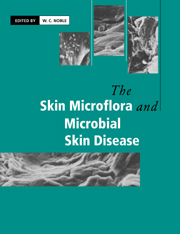Book contents
- Frontmatter
- Contents
- List of contributors
- Preface
- 1 The basis of the skin surface ecosystem
- 2 Nutrition of cutaneous resident microorganisms
- 3 Physical factors affecting the skin flora and skin disease
- 4 Coryneform bacteria
- 5 Coryneforms as pathogens
- 6 Staphylococci on the skin
- 7 Staphylococci as pathogens
- 8 Streptococci and the skin
- 9 Other cutaneous bacteria
- 10 Fungi and fungal infections of the skin
- 11 Bacterial and fungal skin disease in animals
- 12 Viral skin disease in man
- 13 Viral skin disease in animals
- 14 Microbial interactions on skin
- 15 Adherence of skin microorganisms and the development of skin flora from birth
- 16 Skin disinfection
- Index
5 - Coryneforms as pathogens
Published online by Cambridge University Press: 04 December 2009
- Frontmatter
- Contents
- List of contributors
- Preface
- 1 The basis of the skin surface ecosystem
- 2 Nutrition of cutaneous resident microorganisms
- 3 Physical factors affecting the skin flora and skin disease
- 4 Coryneform bacteria
- 5 Coryneforms as pathogens
- 6 Staphylococci on the skin
- 7 Staphylococci as pathogens
- 8 Streptococci and the skin
- 9 Other cutaneous bacteria
- 10 Fungi and fungal infections of the skin
- 11 Bacterial and fungal skin disease in animals
- 12 Viral skin disease in man
- 13 Viral skin disease in animals
- 14 Microbial interactions on skin
- 15 Adherence of skin microorganisms and the development of skin flora from birth
- 16 Skin disinfection
- Index
Summary
In Chapter 4 the evolving taxonomy of the coryneform bacteria was discussed, as well as their role as members of the resident skin flora. The excellent review of Coyle and Lipsky discusses the coryneforms, particularly the multipleantibiotic resistant Corynebacterium jeikeium and group D2, that have been associated with systemic infections and difficult to treat urinary tract infections. Corynebacterium xerosis has been identified as a cause of endocarditis, septicaemia and osteomyelitis. Likewise, C. minutissimum has been described as a cause of septicaemia and endocarditis.
In cutaneous infections, C. diphtheriae is clearly involved both as a primary pathogen as well as in secondary superinfection of other cutaneous infections such as syphilis and streptococcal pyoderma. There are several cutaneous lesions from which coryneforms can be recovered and in which they are seen as playing important pathophysiological roles. These include trichomycosis axillaris, erythrasma, interdigital toe-web space infections, acne and pitted keratolysis.
Trichomycosis axillaris
Trichomycosis axillaris commonly comprises waxy, nodular coatings on the axillary hair shafts of individuals with poor hygiene. Similar lesions can arise, but less frequently, in the pubic and beard areas. Not infrequently, the waxy nodules may be red, black or yellow and will fluoresce a variety of colours under Wood's ultraviolet light.
Crissey and coworkers gave the name ‘C. tenuis’ to the coryneforms recovered from trichomycosis axillaris. They found a number of very different colonial morphologies with varying biochemical reactions among 31 isolates studied.
- Type
- Chapter
- Information
- The Skin Microflora and Microbial Skin Disease , pp. 118 - 134Publisher: Cambridge University PressPrint publication year: 1993



